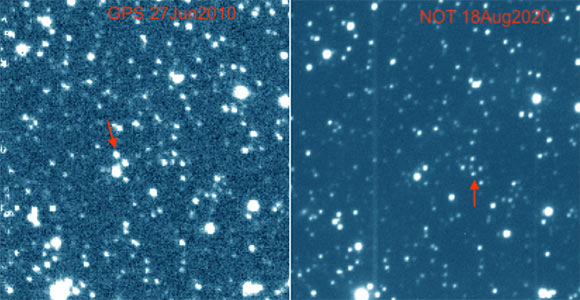WISE 1810055-1010023 (WISE 1810 for short), a metal-poor brown dwarf located 8.9 parsecs (29 light-years) away, is nearly 10 billion years old.

Images of WISE 1810 from the UKIDSS Galactic Plane Survey (left) and NOT ALFOSC (right). The object is indicated by a red arrow. North is up and east left. Each image is about 80 arcsec across. Image credit: Lodieu et al., doi: 10.1051/0004-6361/202243516.
Brown dwarfs are cool, dim objects that have a size between that of a gas giant planet, such as Jupiter or Saturn, and that of a Sun-like star.
Sometimes called failed stars, these objects are too small to sustain hydrogen fusion reactions at their cores, yet they have star-like attributes.
Typically, they have masses between 11-16 Jupiters (approximate mass at which deuterium fusion can be sustained) and 75-80 Jupiters (approximate mass to sustain hydrogen fusion).
Finding brown dwarfs of different ages and metallicities is critical to tracing their evolutionary paths and understanding the processes of their formation.
Since the discoveries of the first two brown dwarfs announced in 1995, the field has grown significantly with thousands of such objects with a wide range of physical properties: mass, age, atmospheric composition. Nonetheless, metal-poor dwarfs at or below the hydrogen-burning limit still remain scarce.
“On a cosmic scale, our immediate neighborhood is composed of just a few hundred stars and brown dwarfs with their own planetary systems,” said Dr. Nicolas Lodieu, an astronomer with the Instituto de Astrofísica de Canarias and the Departamento de Astrofisica at the Universidad de La Laguna, and his colleagues.
“Unlike stars, brown dwarfs do not have enough mass to sustain nuclear fusion of hydrogen, which is the energy source of stars like the Sun, so they fade over time.”
“Because of their low luminosity and energy, they are very difficult to detect. However, their study is essential for understanding the processes of star and planet formation.”
Using the OSIRIS, EMIR and HiPERCAM instruments on the Gran Telescopio Canarias, the ALFOSC instrument on the Telescopio Óptico Nórdico, and the Omega2000 instrument on the Calar Alto Astronomical Observatory, the astronomers observed WISE 1810, a candidate metal-poor brown dwarf discovered in 2020.
“This type of brown dwarf has an atmosphere devoid of substances such as nitrogen and carbon,” they said.
The authors found that WISE 1810 has a temperature of 525 degrees Celsius, a luminosity one millionth of the Sun, and a mass in the brown dwarf regime.
“The new brown dwarf has very peculiar photometric and spectroscopic properties that will require new investigations,” Dr. Lodieu said.
“None of the current atmospheric models can reproduce the light emitted by this peculiar object over a wide wavelength range.”
“We cannot see traces of ammonia and methane at near-infrared wavelengths deducing that the atmosphere has about 3% of the solar chemical composition but with large uncertainty,” said Dr. María Rosa Zapatero Osorio, an astronomer with the Centro de Astrobiología (CSIC-INTA).
“This is the first time that the presence of such dim, metal-depleted objects in our Galaxy has been confirmed.”
“WISE 1810 is a water vapor world because steam and molecular hydrogen are the only strong features we can see in the object’s spectral energy distribution,” said Dr. Eduardo Martín, an astronomer with the Instituto de Astrofísica de Canarias and the Departamento de Astrofisica at the Universidad de La Laguna, and the Consejo Superior de Investigaciones Científicas.
“Future observations may confirm that such types of brown dwarfs are more common than we thought, which will change our view of how stars and brown dwarfs formed in the early Milky Way,” Dr. Lodieu said.
A paper on the findings was published in the journal Astronomy & Astrophysics.
_____
N. Lodieu et al. 2022. Physical properties and trigonometric distance of the peculiar dwarf WISE J181005.5-101002.3. A&A 663, A84; doi: 10.1051/0004-6361/202243516







